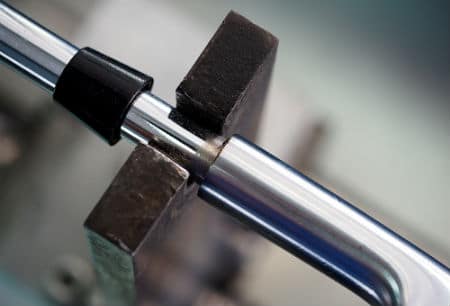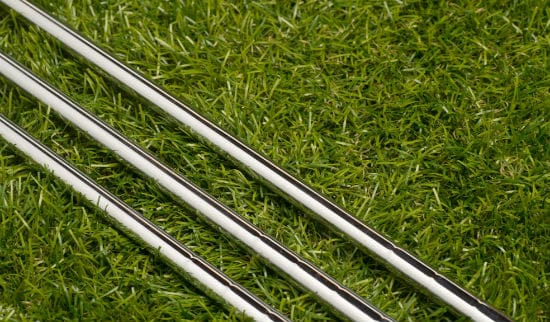Graphite vs. steel shafts, if you were to ask a golfer to describe the difference between these two materials that are used in the manufacturing of golf club shafts you would get a variety of different answers.
Majority of professional players use graphite shafts in their woods and steel shafts in their irons. For beginners and high handicappers graphite shafts would be best but it isn’t a must, there are many other factors that contribute to which shaft you should play with.
Graphite shafts are available in a big variety of flex and weight options, graphite shafts also offer exceptional fees, in comparison steel shafts tend to be heavier but they are more durable than graphite shafts.
Below we will review these two golf club shaft materials in depth in order to determine which shaft type is best in general or which one should you senior, high and low handicappers choose.
Graphite vs Steel Shafts: Quick Comparison
Winner |
Graphite Shafts
|
Check Price |
Cheaper |
Steel Shafts
|
Check Price |
Graphite vs. Steel Shafts: Differences and Similarities
Weight
Graphite shafts and steel shafts vary drastically in offering in terms of weight. Steel shafts and steel iron shafts, in particular, are on the heavier side of the spectrum. Light steel shafts weigh between 90 and 100 grams, majority of steel shafts weigh above 100 grams.
Graphite shafts offer more flexibility in terms of weight. Graphite iron shafts are available in options that weigh anywhere between 70 and 130 grams.
Graphite shafts are the preferred shaft of choice for senior and female players due to the fact that graphite shafts are available in extreme lightweight options.
Price
Steel shafts are made from a single material and are very affordable to produce. Graphite shafts, on the other hand, carry more expensive price tags in general.
The manufacturing process of graphite shafts are rather complex, multiple layers of carbon fiber are bound together by resin and it is covered with a thin wrap of cellophane. This advanced process is the main reason why graphite shafts are more expensive than steel shafts.
Durability
In terms of durability, steel shafts emerge victorious. Steel shafts are extremely durable and if taken care of properly they can last for decades without compromising on performance.
Maintenance is key to ensure the longevity of steel shafts, make sure to store your golf clubs in a dry area to prevent rust.
In comparison graphite shafts are far less durable than steel shafts. Graphite shafts tend to lose their flex over time and these lightweight shafts are also at risk of cracking or peeling.
Shock Absorption
Graphite shafts win the shock absorption battle hands down. When a golfer hits the ball with a club with a steel shaft, vibrations are sent up through the shaft and these vibrations can be felt in the hands of the golfer.
These vibrations may leave a stinging sensation in the player’s hands especially after a mishit shot in cold conditions.
In comparison graphite shafts absorb the vibrations that are generated at impact. Professional players prefer the vibrations that can be felt when playing with steel shafts, to them it serves a purpose and it gives them feedback as to whether or not they hit a good shot.
Graphite shafts and their ability to absorb vibrations is ideal for golfers who suffer from hand-related health issues such as arthritis.
Accuracy
In terms of accuracy, there is no clear winner between steel and graphite shafts. Accuracy is affected by a wide variety of factors including weight, shaft flexibility, torque and kick points. Additionally, spin and clubhead combinations also affect accuracy.
Based on the opinion of many golfers, speculation is that steel shafts provide more accuracy than graphite shafts. This statement is just speculation, graphite shafts feature high-quality designs that provide exceptional accuracy.
Launch (Trajectory)
Shaft types and weight can have a significant effect on golf ball trajectories. Lightweight shafts tend to promote mid – high ball flights, alternatively heavier shafts promote lower more penetrating ball flights.
Steel shafts are heavier shafts in comparison to graphite shafts. Players that struggle to launch their golf ball into the air will without a doubt benefit more by using a lightweight graphite shaft in their irons.
The opposite is true for players with high ball flights, the use of a heavier steel shaft will assist with producing a lower more penetrating ball flight which in return will ensure greater control and accuracy.
Spin
The spin rate of the golf ball is directly correlated to how the golf ball is hit. Well struck shots will have optimal spin rates and the opposite will be true for bad shots. Optimal spin rates are required in order to ensure accuracy and control.
Shaft types, as well as the clubhead, affect spin rates. Both graphite and steel shafts are available in a variety of options that produce different spin rates.
In order to ensure that the shafts you are playing with are producing optimal spin rates seek advice from a qualified PGA professional/club fitter.

Steel vs. Graphite Irons
Golf Clubs with Graphite and Steel Shafts Pros and Cons
Graphite and steel shafts are both great for a variety of different reasons. Let’s take a closer look at the pros and cons of irons with either steel or graphite shafts
Steel Irons
Pros
- Durable design
- Affordable price tag
- Provides feedback on the quality of the strike due to the fact that steel shafts don’t absorb vibrations
Cons
- Limited options in terms of shaft weight
- Limited shock absorption
Graphite Irons
Pros
- Available in a wide variety of shaft weight options
- Lightweight graphite shafts promote higher trajectories
- Graphite shafts are exceptional at absorbing the vibrations that are generated by hitting a golf ball
Cons
- Graphite shafts are on the higher end of the price spectrum
- Lacks long term durability due to the design/manufacturing of these shafts
Advantages of Graphite Shafts
By now it’s pretty evident that there are many benefits to using graphite shafts in both your woods and irons.
Graphite shafts are available in a wide range of weight options, they promote exceptional feel and they can offer that much-needed boost that seniors, ladies, and players with slow swing speeds require in order to improve their golf game.
Disadvantages
Graphite shafts have a lot going for them, but they do have some disadvantages. Graphite shafts carry above-average price tags and due to the complexity of its design graphite shafts tend to lack long term durability in comparison to steel shafts.
Do Pros Use Graphite or Steel Iron Shafts?
When we look at “what’s in the bag” for many pro golfers a common trend can be found. Graphite shafts are the shaft of choice for their driver, woods, and hybrids, alternatively steels shafts are used by the majority of players in their irons.
This picture changes drastically when we take a closer look at the women’s game. Female players are always on the hunt for added clubhead speed which in return result in added distance.
Lightweight graphite shafts give ladies professional players the option to play with a stiff yet lightweight shaft.
New graphite shaft designs hit the market on a regular basis and as players continue to seek ways to improve I have no doubt that graphite shafts will be seen more frequently in the irons of professional players around the globe.
Should High Handicappers Use Steel or Graphite Shafts?
There is no right or wrong when answering this question, it depends on a variety of factors including the skill level, age, gender, etc. of the player. Junior and female golfers should without a doubt play with graphite instead of steel shafts.
Graphite shafts are lightweight, forgiving and they promote higher trajectories which is ideal for players with slower swing speeds such as juniors and ladies.
Which Shafts Should Seniors Use?
Senior golfers differ drastically in terms of age and skill level. A senior player that’s 60 years old and that has an average swing speed of 100mph will have a very different set make-up in comparison to an 80-year-old senior player with an average swing speed of 70 mph.
In general, however, senior players should look at using graphite instead of steel shafts throughout their bags for a variety of different reasons. Graphite shafts are available in lightweight options (80 grams and below) which is ideal for older golfers.
In addition to being light graphite shafts also have the ability to absorb the vibrations that are sent up the shaft at impact.
Senior golfers that struggle with arthritis or any other hand related health conditions will benefit a great deal by using graphite shafts.
With age senior players tend to lose distance and height on their shots as a result of slower clubhead speeds. Graphite shafts and in particular lightweight graphite shafts promote higher trajectories which will without a doubt have a positive impact on the course for senior players.

Conclusion
Graphite vs steel shafts: And the winner is…
Both graphite and steel shafts have a host of different advantages and disadvantages. There is no right or wrong answer as to which type of shaft to play with, at the end of the day it will differ from one golfer to the next.
However what we did establish was that steel shafts are affordable, durable and they are utilized mainly in irons.
Graphite shafts, on the other hand, are lightweight and they are utilized mainly in drivers and woods. Graphite shafts, due to their lightweight designs are also very popular amongst seniors and ladies.


 The Golf Einstein © 2021. All Rights Reserved.
The Golf Einstein © 2021. All Rights Reserved.